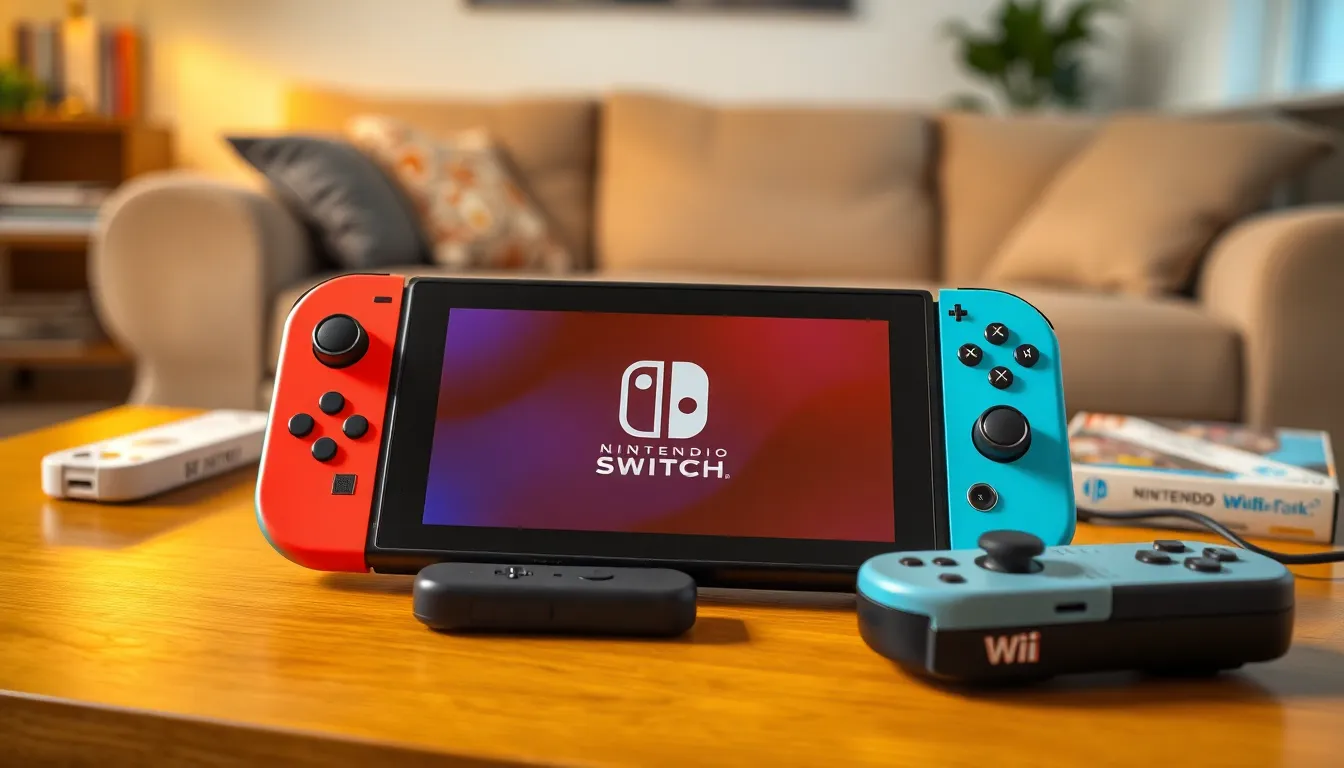Table of Contents
ToggleWhen it comes to gaming nostalgia, few names evoke as much joy as Nintendo. The Wii revolutionized family fun with its motion controls and quirky games, turning living rooms into dance floors and bowling alleys. Fast forward to today, and the Nintendo Switch has taken the gaming world by storm, offering a hybrid experience that lets players game on the go or at home.
Overview of Nintendo Switch and Wii
Nintendo has launched two iconic gaming consoles—the Wii and the Switch. Each console caters to distinct gaming experiences while highlighting Nintendo’s innovative approach to gaming.
Released in 2006, the Wii introduced motion controls, encouraging families to engage in physical activity. Its library, featuring titles like “Wii Sports” and “Mario Kart Wii,” drew players of all ages, making gaming a communal experience. The Wii’s emphasis on accessibility enabled it to reach non-gamers, establishing a significant cultural impact.
In contrast, the Nintendo Switch debuted in 2017, combining handheld and home console capabilities. Players enjoy flexibility with its ability to switch between modes effortlessly. Popular games on Switch, such as “The Legend of Zelda: Breath of the Wild” and “Animal Crossing: New Horizons,” showcase its diverse offerings, appealing to both casual and hardcore gamers.
While the Wii focused on movement and family-oriented play, the Switch embraces a hybrid gaming model. The Switch’s versatility allows for local multiplayer, enhancing social gaming in various settings. As a result, both consoles have played critical roles in shaping Nintendo’s legacy.
Success for both devices lies in their unique approaches. The Wii’s emphasis on physical interaction revolutionized how people perceive gaming, while the Switch’s adaptable nature has secured its status in contemporary gaming culture. Collectively, they illustrate Nintendo’s commitment to innovation and creating enjoyable gaming experiences for all.
Key Features Comparison

The Nintendo Switch and Wii each present unique features that cater to different gaming preferences. A detailed comparison highlights their distinctions.
Hardware Specifications
The Nintendo Switch boasts a custom NVIDIA Tegra processor, supporting both handheld and docked gaming. Its resolution reaches 720p in handheld mode and 1080p in docked mode, enhancing visual quality. The console features 32 GB of internal storage, which is expandable via microSD cards. In contrast, the Wii operates on a custom IBM PowerPC processor, with a maximum resolution of 480p. This difference affects graphics and performance capabilities, with each console serving a distinct target audience. The Wii’s internal storage capacity is 512 MB and can also utilize an external SD card for additional storage.
Control Mechanisms
Nintendo Switch utilizes Joy-Con controllers, offering versatile play styles and motion sensors. These controllers enable both traditional gaming and innovative motion control experiences. Players enjoy the flexibility of using either docked or handheld modes, enhancing social interaction. The Wii introduced motion controls via the Wii Remote, revolutionizing how players interact with games. Users engage through gestures, creating a more immersive experience. Combining the Wii’s movement-centric design with the Switch’s adaptability showcases Nintendo’s evolution in gaming engagement.
Game Library Analysis
Examining the game libraries reveals distinct offerings and experiences between the Nintendo Switch and the Wii. Both consoles boast impressive game selections, catering to different player preferences.
Exclusive Titles
Exclusive titles define each console’s personality. The Wii features iconic games like “Wii Sports” and “Super Mario Galaxy,” emphasizing motion controls and family-friendly gameplay. Players enjoy titles that created memorable experiences, promoting social interactions. The Nintendo Switch, on the other hand, showcases acclaimed exclusives such as “The Legend of Zelda: Breath of the Wild” and “Super Smash Bros. Ultimate.” These games leverage advanced graphics and innovative mechanics, capturing the attention of diverse audiences. Both systems highlight Nintendo’s strength in delivering unique gaming experiences that resonate with players across generations.
Third-Party Support
Third-party support represents another critical aspect of each console’s game library. The Wii enjoyed some third-party titles, but limitations in graphics hampered extensive support. Popular games like “Call of Duty: Modern Warfare” found a home, though the library remained primarily Nintendo-focused. In contrast, the Nintendo Switch garners robust third-party support, attracting major developers. Titles like “The Witcher 3” and “Doom Eternal” illustrate this appeal. Players benefit from a broader selection, enhancing the Switch’s versatility and overall gaming experience. The increasing third-party contributions significantly enrich the game library for the Nintendo Switch.
User Experience
Nintendo emphasizes user experience in both the Switch and Wii, ensuring players enjoy immersive gaming. Each console offers distinct interfaces and online capabilities that enhance engagement.
Interface and Accessibility
Switch features an intuitive interface, allowing quick access to games and features. Its touch screen simplifies navigation, while Joy-Con controllers accommodate various play styles. Accessibility remains a priority, providing options for players with different abilities. Wii’s interface, though simpler, still fosters ease of use with straightforward menus. Remote controls emphasize motion input, promoting an active gaming experience. The design of both systems caters to diverse audiences, from casual players to families seeking shared fun.
Online Features
Nintendo Switch Online enhances connectivity with multiplayer abilities and cloud saves. Subscription options afford access to a library of classic NES and SNES games, enriching gameplay experiences. Exclusive online services foster community engagement, evident in popular games like “Splatoon 2” and “Super Smash Bros. Ultimate.” Wii, on the other hand, offered limited online features. The WiiConnect24 service provided messaging and updates but lacked robust multiplayer capabilities. Switch’s advanced online services vastly improve overall user experience in comparison.
Market Impact and Sales
The market impact of the Wii and Switch reflects Nintendo’s strategic evolution. Launched in 2006, the Wii achieved remarkable sales, surpassing 101 million units globally. This success stemmed from its innovative motion controls, attracting casual gamers and families. Notable titles like “Wii Sports” propelled its popularity, establishing new gaming demographics.
In 2017, the Nintendo Switch entered the market, revolutionizing home console and portable gaming. This hybrid model quickly gained traction, with sales exceeding 125 million units in just a few years. The Switch appealed to both casual and hardcore gamers, expanding the user base significantly. Iconic games like “The Legend of Zelda: Breath of the Wild” and “Animal Crossing: New Horizons” contributed to this surge, reinforcing its versatility and engaging gameplay.
Third-party developer support varies between the two consoles, impacting their respective libraries and sales. The Wii, despite its immense initial success, faced limitations due to outdated graphics capabilities. Consequently, it attracted fewer third-party titles. In contrast, the Switch’s robust performance and modern specs fostered relationships with major developers, leading to a diverse game roster. Games like “The Witcher 3” and “Doom Eternal” exemplify this partnership, enhancing the Switch’s appeal.
User experience relates directly to market performance as well. The Wii’s emphasis on physical movement appealed to families, creating a communal gaming experience. Meanwhile, the Switch’s focus on portability and local multiplayer enhances social gaming. Both consoles emphasized accessibility, catering to various player abilities while fostering inclusivity.
Online services also distinguish their market positions. Subscribers of Nintendo Switch Online benefit from multiplayer access and cloud saves, reinforcing the platform’s connectivity. The Wii, on the other hand, had limited online capabilities, which affected its long-term engagement. Overall, these factors illustrate the significant market impact and sales potential of both the Wii and Switch, shaping Nintendo’s legacy in gaming.
The Nintendo Switch and Wii each carved out unique spaces in the gaming landscape. The Wii’s innovative motion controls and family-friendly approach brought gaming into homes in a new way. It created memorable experiences that appealed to players of all ages.
On the other hand, the Switch’s hybrid design and robust game library represent a significant evolution in gaming. Its ability to seamlessly transition between handheld and home console play caters to a diverse audience, enhancing social interactions through local multiplayer.
Both consoles have left an indelible mark on gaming culture. While the Wii focused on physical engagement and communal play, the Switch embraces versatility and a broader gaming experience. Nintendo’s commitment to innovation continues to shape the future of gaming.




